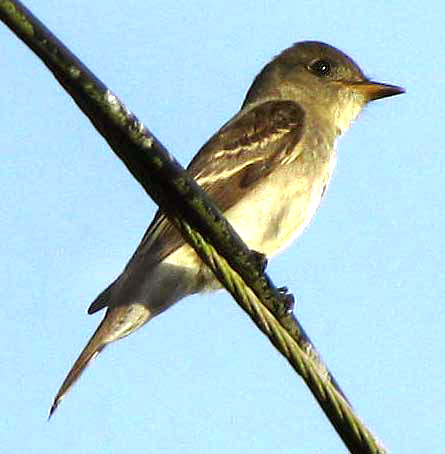Excerpts from Jim Conrad's
Naturalist Newsletter
from the October 20, 2008 Newsletter written in Yokdzonot about half an hour by bus west of Pisté, Yucatán, México
elevation ~25m (~82 ft), N20.707°, W88.731°
WHICH PEWEE?
An ambiguous flycatcher species has been making the rounds around the cenote, the one shown below:

Similar small size as the Least Flycatcher so common here, same flycatching behavior, same mousy colors, same wingbars... but notice the missing eyering. Also the bird wasn't flipping its tail.
This isn't a phoebe because phoebes have black beaks and flip their tails. It's not an Empidonax flycatcher because they have eyerings. That leaves the pewees, genus Contopus, of which five species occur in Mexico, but only two in the Yucatán. There's the permanent-resident Tropical Pewee, and the migrant Eastern Pewee, who passes through at this time of year heading toward wintering grounds in South America. So: Tropical or Eastern?
These two pewees have very different voices, so that's the main distinguishing feature if they're singing, which this one was not. Howell says that after the voices the thing to look for is that Tropical Pewees have "shorter primary projections" -- the wings' primary feathers extend a relatively shorter distance beyond the secondary feathers than the Eastern's. The picture doesn't enable us to see that feature and I couldn't see it through my binoculars, so that doesn't help.
The Tropical's bill is described as "pale orangish below, rarely with dusky tip," while the Eastern's bill is said to be "pale orangish below, often with dark tip." Our bird's lower mandible is quite dark, so that's a vote for "Eastern."
The main clue to the bird's identity is this, however: Early most mornings for the last week I've heard brief outbursts of the plaintive, slurred d-WEEEEE so typical of the Eastern Pewee, so I'm guessing that the bird in the picture is an Eastern Pewee, CONTOPUS VIRENS, who's just flown across the Gulf of Mexico and is refueling now before continuing his journey to South America.